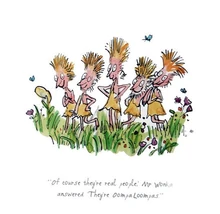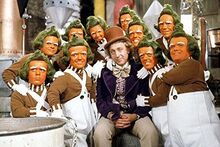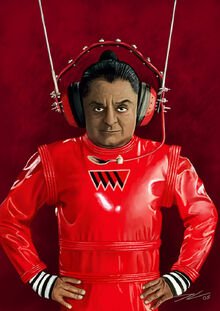No edit summary Tags: Visual edit apiedit |
(added a little more info) |
||
| (47 intermediate revisions by 33 users not shown) | |||
| Line 1: | Line 1: | ||
| + | [[File:Oompa-Loompas-quentin-blake.jpg|thumb|220x220px]] |
||
| − | '''Oompa-Loompas''' are fictional characters from [[Roald Dahl|Roald Dahl's]] books ''[[Charlie and the Chocolate Factory]]'' and ''[[Charlie and the Great Glass Elevator]]''. |
||
| + | <nowiki/> |
||
| + | The '''Oompa-Loompas''' were the workers at [[Willy Wonka's Chocolate Factory]], who were imported by [[Willy Wonka]] direct from [[Loompaland]]. |
||
| − | ==History== |
||
| ⚫ | |||
| ⚫ | |||
| − | They come from Loompaland, which is a region of [[Loompa]], a small isolated island in the Pacific Ocean. The Oompa-Loompas would end up being preyed upon or attacked by Whangdoodles, Hornswogglers and Snozzwangers. Wonka ended up inviting them to work at his factory and get away from their natural enemies. In the book, they are the only people [[Willy Wonka]] will allow to work in his factory, because of the risk of [[industrial espionage]] committed by his candy-making rivals. They are only knee-high, with astonishing [[haircut]]s, and are paid in their favorite food, [[cacao bean]]s. They insist on maintaining their native clothing: men wear skins, women wear leaves, and children wear nothing at all (In both movies, they wore typical factory worker uniforms). Only the male Oompa-Loompas are seen working in the factory, though in Quentin Blake's illustrations, both male and female Oompa-Loompas are shown rolling away Violet Buereguard after her transformation into a blueberry. Presumably the females remain in the village seen briefly from the Great Glass Elevator. |
||
| + | <blockquote>They come from Loompaland, which is a region of [[Loompa]], a small isolated island in the hangdoodles.</blockquote> |
||
| ⚫ | |||
| + | When Mr. Wonka went to Loompaland and saw the terrible conditions in which the Oompa Loompas were living, he invited them to come and work at his factory to get away from the terrible country they inhabited and the creatures that preyed on them: namely, the Whangdoodles, the Hornswogglers and the Snozzwangers. |
||
| − | ==Adaptations== |
||
| ⚫ | * In the 2005 film |
||
| + | In the book, the Oompa Loompas are the only people Mr. Wonka will allow to work in his factory, because of the risk of industrial espionage committed by his candy-making rivals. They are only knee-high, with astonishing haircuts, and are paid in their favorite food, [[cocoa bean]]s, which were difficult to find in Loompaland. Although the Oompa Loompas initially spoke only their own language, Oompa-Loompish (which Mr. Wonka was fortunately fluent in), they all now spoke English. However, the Oompa Loompas insisted on retaining their native clothing: men wore skins and women wore leaves, while the children wore nothing at all. (In both movies, they wore typical factory worker uniforms.) |
||
| ⚫ | * In the 1971 film ''[[Willy Wonka & the Chocolate Factory]]'', they are portrayed as orange skinned and were portrayed by [[Rudy Borgstaller]], [[George Claydon]], [[Malcolm Dixon]], [[Rusty Goffe]], [[Ismed Hassan]], [[Norman McGlen]], [[Angelo Muscat]], [[Pepe Poupee]], [[Marcus Powell]], and [[Albert Wilkinson]]. In the film, [[ |
||
| + | |||
| + | Only the male Oompa-Loompas are seen working in the factory, though in Quentin Blake's illustrations, both male and female Oompa-Loompas are shown rolling away Violet Beauregarde after her transformation into a blueberry. Presumably, the females remain in the village seen briefly from the Great Glass Elevator. |
||
| + | [[File:51sXp25L0iL. SX466 .jpg|thumb|220x220px]] |
||
| ⚫ | |||
| + | [[File:Oompa Loompa by Tyrus88.jpg|thumb|311x311px]] |
||
| ⚫ | * In the 2005 film adaptation of ''[[Charlie and the Chocolate Factory (film)|Charlie and the Chocolate Factory]]'' starring [[Johnny Depp]], the Kenyan actor [[Deep Roy]] played all 165 Oompa Loompas. Deep Roy had to take Pilates and dance classes for this role which involves numerous songs and dances. Also, he was dressed as some female Oompa-Loompas that worked in the administration offices. |
||
| + | |||
| ⚫ | * In the 1971 film ''[[Willy Wonka & the Chocolate Factory]]'', they are portrayed as orange skinned and were portrayed by [[Rudy Borgstaller]], [[George Claydon]], [[Malcolm Dixon]], [[Rusty Goffe]], [[Ismed Hassan]], [[Norman McGlen]], [[Angelo Muscat]], [[Pepe Poupee]], [[Marcus Powell]], and [[Albert Wilkinson]]. In the film, [[Vermicious Knids]] were also the Oompa-Loompas' enemies alongside the Whangdoodles, Hornswogglers and Snozzwangers. |
||
==References== |
==References== |
||
| − | {{reflist}} |
+ | {{reflist}}[[File:OompaLoompaHD.png|thumb|220x220px]] |
==External links== |
==External links== |
||
| − | * [http://kids.niehs.nih.gov/lyrics/oompa.htm Oompa-Loompa Songs] at the website of the |
+ | * [http://kids.niehs.nih.gov/lyrics/oompa.htm Oompa-Loompa Songs] at the website of the NationCHNEal Institute of Environmental Health Sciences |
* [http://www.roalddahlfans.com/books/charsongs.php Official Oompa–Loompa Songbook] - Roalddahlfans.com |
* [http://www.roalddahlfans.com/books/charsongs.php Official Oompa–Loompa Songbook] - Roalddahlfans.com |
||
* [http://www.roalddahlfans.com/books/charoompa.php Politically Correct Oompa–Loompa Evolution] - Roalddahlfans.com |
* [http://www.roalddahlfans.com/books/charoompa.php Politically Correct Oompa–Loompa Evolution] - Roalddahlfans.com |
||
| + | [[Category:Willy Wonka characters]] |
||
| + | [[Category:Willy Wonka and The Chocolate Factory]] |
||
| + | [[Category:Charlie and the Chocolate Factory]] |
||
| + | [[Category:Male characters]] |
||
| + | [[Category:Female characters]] |
||
| + | [[Category:Movies]] |
||
| + | [[Category:Books]] |
||
[[Category:Characters]] |
[[Category:Characters]] |
||
Revision as of 16:05, 10 September 2019

The Oompa-Loompas were the workers at Willy Wonka's Chocolate Factory, who were imported by Willy Wonka direct from Loompaland.
In the early edition of the novel, they are shown as African pygmies. Following criticism, in later editions of the book, they are white skinned and golden hair. [1]
They come from Loompaland, which is a region of Loompa, a small isolated island in the hangdoodles.
When Mr. Wonka went to Loompaland and saw the terrible conditions in which the Oompa Loompas were living, he invited them to come and work at his factory to get away from the terrible country they inhabited and the creatures that preyed on them: namely, the Whangdoodles, the Hornswogglers and the Snozzwangers.
In the book, the Oompa Loompas are the only people Mr. Wonka will allow to work in his factory, because of the risk of industrial espionage committed by his candy-making rivals. They are only knee-high, with astonishing haircuts, and are paid in their favorite food, cocoa beans, which were difficult to find in Loompaland. Although the Oompa Loompas initially spoke only their own language, Oompa-Loompish (which Mr. Wonka was fortunately fluent in), they all now spoke English. However, the Oompa Loompas insisted on retaining their native clothing: men wore skins and women wore leaves, while the children wore nothing at all. (In both movies, they wore typical factory worker uniforms.)
Only the male Oompa-Loompas are seen working in the factory, though in Quentin Blake's illustrations, both male and female Oompa-Loompas are shown rolling away Violet Beauregarde after her transformation into a blueberry. Presumably, the females remain in the village seen briefly from the Great Glass Elevator.

They are also mischievous, love practical funny jokes, and singing. As each bad child makes his/her exit, they sing moralizing songs accompanied by a drum beat. Some of the rhymes were amusing, but the parents of the bad kids did not find them as funny as Charlie did.

- In the 2005 film adaptation of Charlie and the Chocolate Factory starring Johnny Depp, the Kenyan actor Deep Roy played all 165 Oompa Loompas. Deep Roy had to take Pilates and dance classes for this role which involves numerous songs and dances. Also, he was dressed as some female Oompa-Loompas that worked in the administration offices.
- In the 1971 film Willy Wonka & the Chocolate Factory, they are portrayed as orange skinned and were portrayed by Rudy Borgstaller, George Claydon, Malcolm Dixon, Rusty Goffe, Ismed Hassan, Norman McGlen, Angelo Muscat, Pepe Poupee, Marcus Powell, and Albert Wilkinson. In the film, Vermicious Knids were also the Oompa-Loompas' enemies alongside the Whangdoodles, Hornswogglers and Snozzwangers.
References

External links
- Oompa-Loompa Songs at the website of the NationCHNEal Institute of Environmental Health Sciences
- Official Oompa–Loompa Songbook - Roalddahlfans.com
- Politically Correct Oompa–Loompa Evolution - Roalddahlfans.com